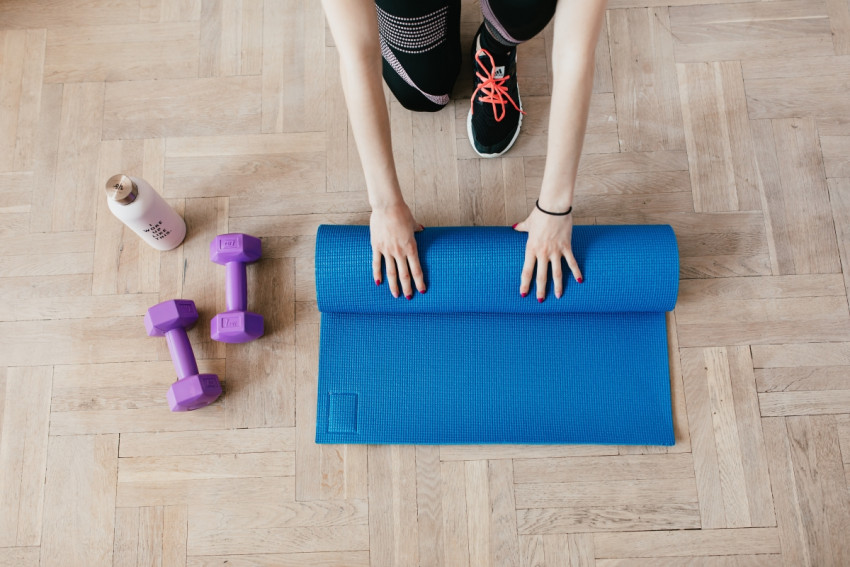
With more and more brands selling yoga mats, people who practice yoga tend to get confused on which yoga mat to buy. In this blog, we will decode the process of buying the perfect yoga mat for you. We will take away your stress of choosing the best one and help you select a comfortable yoga mat for you.
What to look for in a yoga mat
Once you’ve done your research and had a chance to try out your new yoga mat, it's time to perform some maintenance and ensure that it lasts for years to come. Below are some common maintenance questions and tips on how to take care of your yoga mat:
How do I keep my mat clean? And when should I wash it?
You should clean your mat after every few uses, or whenever you notice the surface is feeling sticky. Wipe down both sides with a damp cloth or towel—using a mild soap if needed—and then let air dry. After cleaning, you might feel the need to spray on another layer of water repellent since that can wear off over time. Be sure not to use bleach or harsh cleaners as these will damage the material!
My mat has a funky smell! What now?
Your yoga mat may become smelly from absorbing sweat during workouts and from oils from your skin transferring onto its surface. The best way to get rid of the odor is by wiping it down with a wet cloth followed by letting air dry completely without folding it up. If this doesn't work, take advantage of the cleaning tips mentioned above; in particular, consider using more strong cleaners like vinegar, as well as spraying on water repellent for future sweat absorption prevention.
Yoga type
What type of yoga do you practice?
Some types of yoga, like Yin, are generally practiced sitting or lying down. Others, like Ashtanga and Bikram, have more standing poses and a faster pace. The frequency with which you'll be on your hands and knees can impact the thickness and material of the mat that will work best for you.
If you have sweaty hands or feet but prefer a mat that doesn't offer much padding, try one with a grippy surface to help prevent slipping. Alternatively, if you're more prone to slipping on mats due to physical reasons (for example, if your palms are small) then look for one with a good grip.
How often will you use the mat?
If your mat is intended for home use only, then consider an option that's thicker than what you'd want for taking to class at a studio or gym. Having your own dedicated home yoga practice space can be lovely in many ways; however, it does mean that you'll likely need to clean and roll up your mat every time—and it also means that sweating (particularly if there are no windows in your practice space) can cause bacteria growth over time. Either of these factors can shorten the lifespan of a thin yoga mat.
Yoga mat thickness
Your body's needs and the way you practice should determine your mat's thickness. If you're a beginner, a thicker mat can be useful because it provides more support for your joints. Some yogis like having thick mats so that they can jump around without worrying about hurting their knees or feet or avoiding the feel of hardwood floors. But if you travel frequently and need to pack your mat in a small bag or suitcase, thinner is better — otherwise, you'll end up with bulky luggage! No one wants to check a bag at an airport just because they don't want to sacrifice comfort on the yoga mat front.
And if you're looking for even more cushioning, consider getting yourself a padded yoga mat.
Yoga mat material
For some, this will be the most important factor in choosing a mat. You may have an allergy to certain materials or want to avoid anything derived from animals. For others, it might be an afterthought—as long as it’s not stinky or feels slippery, you’re good!
But what about those in between? Here's a quick guide:
Cotton and jute are natural fibers that are often used for their biodegradability and eco-friendly qualities. They're also made into sustainable towels that are great for your practice when you've worked up a sweat. However, they often lack padding so you may prefer to use them on top of another mat!
Many mats are made from natural rubber; this material is usually more grippy than PVC and better for the environment. A lot of these mats require breaking in before they'll grip well—just know that once you get there, it's totally worth it!
PVC is the most common material used for yoga mats because it isn't expensive and lasts for a long time—but since it's not durable enough to biodegrade naturally, we don't recommend using PVC if you care about sustainability (i.e., keeping the Earth from being destroyed by trash).
Yoga mat grip
Your mat needs to be grippy enough to keep you from sliding all over the place, but not so grippy that it feels like you're practicing on a piece of sandpaper. The best way to find the right balance is by trying out as many mats as possible. This will not only familiarize you with different materials and textures but also give you a sense of what kind of yoga mats suit your particular practice, whether that's hot yoga or more of an alignment-based flow.
Yoga mat size and portability
As you browse yoga mat options, you'll notice that there are three main sizes: standard, long, and extra-long. When it comes to comfort (not to mention injury prevention), length is the most important factor. Consider an extra-long mat if you're taller than average or have any mobility issues with your joints. However, if portability is a huge concern for you—maybe because you travel a lot or participate in classes outside of your home—you'll want to pay close attention to the thickness and weight of the mats you're considering. Extra-thick mats are heavy, so they can be a hassle if you need to carry yours around frequently. If possible, choose a lightweight high-performance option with plenty of cushioning.
What is the best yoga mat?
Tego Yoga Mat: The Tego Yoga Mat is the gold standard of yoga mats. Everything about it was designed to be as durable and sustainable as possible, from the low-density cushioning (which allows for a lighter mat without sacrificing support) to the thick weave that makes it super tough and resistant to abrasions, tears, or peeling. Its grip improves with sweat, so if you sweat a lot during practice (especially during hot yoga), this mat is a great choice.
Konex Yoga Mat: This mat is made from 100 percent natural rubber and has an open-cell structure that allows air to flow through the material—a design feature meant to prevent the buildup of bacteria inside the mat. It's also dirt-resistant, meaning your mat will stay cleaner for longer.
Eco Corner Yoga Mat: Another high-quality eco option, this mat is made from sustainably harvested tree rubber with no toxic glues or foams added to the mix—so if you're looking for something completely free of chemicals and additives, this is it. It's also heavy enough that even if you're practicing on carpet or grass, there's little room for slippage (although we recommend still rolling out your yoga towel just in case). This product comes in four different thicknesses—1/8 inch (perfect for travel), 1/4 inch (for those who prefer cushioning), 3/16 inch (for those who want something right in between), and 3/32 inch (for people who like a less cushy feel).
All yoga mats have the same goal, but their features vary.
Yoga mats are designed for the sole purpose of helping you perform yoga. They provide a non-slip surface and cushioning to help you feel more comfortable when performing poses on hard floors. Yoga mats are generally made with synthetic materials such as PVC or foam, but some companies have started making biodegradable options such as jute and natural rubber. Mats come in a variety of thicknesses, but the standard is 1/8 inch thick.
It's important to consider how often you plan on practicing yoga before investing in a mat. Beginners might not need anything fancy, while serious yogis will benefit from more expensive, high-quality products that will last longer through rigorous use. Additionally, if you're tall or have limited storage space at home, it might be worth your while to look into extra-long or foldable options.



